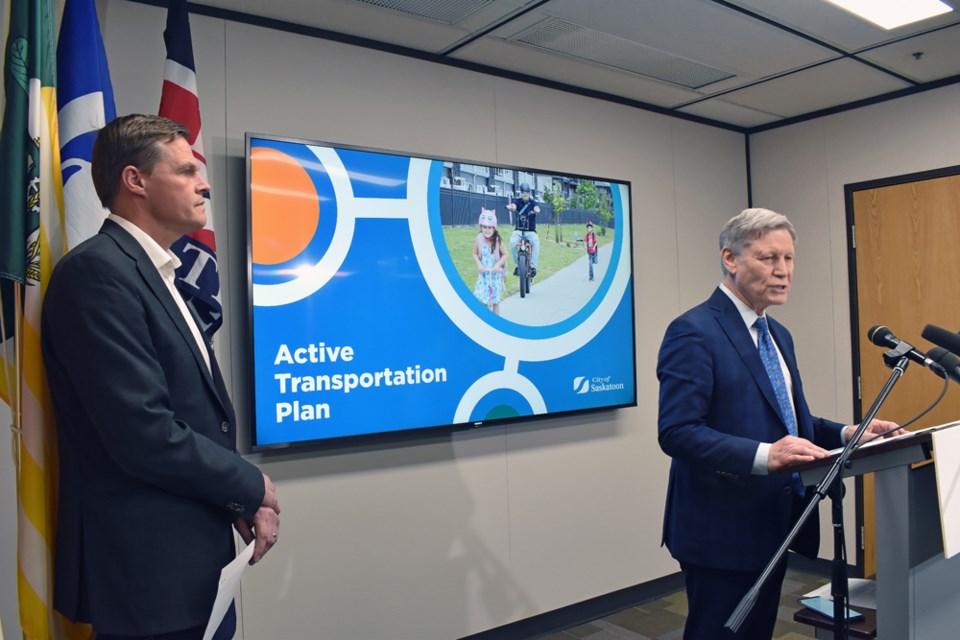SASKATOON — Mayor Charlie Clark acknowledges that transportation, how people get from one place to another in cities, is evolving. He says he is thankful for the federal government’s multimillion-dollar investment to improve the city’s pedestrian and cycling infrastructures.
Clark and Parliamentary Secretary to the Minister of Environment and Climate Change Terry Duguid announced on Friday, March 17, a joint investment of over $2.6 million in constructing a pedestrian pathway and neighbourhood bikeway on Dudley Street between Dawes Avenue and Spadina Crescent.
“Yes, transportation is changing and if you look out at the landscape, you got scooters. Nowadays, we have many people travelling on electric bikes. [Ward 3] Councillor [David] Kirton, who lives out the on the west side, has told me directly that Dudley Street is the area where he uses an electric bike and that's the way that he gets around a lot,” said Clark.
The Canadian government is investing $1,610,031 in the pedestrian and cycling infrastructures project, with the money coming from the Active Transportation Fund. The City of Saskatoon will contribute $1,073,354.
The project will add one kilometre of multi-use pathway west of Avenue P South, 800 metres of neighbourhood bikeway, and about one kilometre of sidewalk to connect residential neighbourhoods with the employment areas of West Industrial, recreational spaces and the Meewasin Trail along the South Saskatchewan River.
Duguid, the MP representing the riding of Winnipeg South, said the federal government is focused on having prosperous and resilient communities in the country with intense climate change action in mind, growing the economy, and creating good middle-class employment opportunities.
“Reliable community infrastructure such as roads, water and wastewater, community centres and public transit is important to our towns and cities. That is why we must continue investing in projects to support communities nationwide. I’m excited to announce [the federal] government is investing [over] $1.6 million to expand Saskatoon’s active transportation infrastructure,” said Duguid.
“As we look to the future, it’s vitally important that we keep making investments in our active transportation infrastructure here in Saskatoon. The new pedestrian and cycling infrastructure on Dudley Street will make it easier for community members to choose safe, clean, affordable transportation options.” Duguid, who spoke on behalf of the Minister of Intergovernmental Affairs, Infrastructure and Communities Dominic LeBlanc.
Duguid added that investments in active transportation infrastructures like these make communities better for everyone to live, work and play.
Clark thanked the federal government for investing in and supporting the joint project where the funding announcement contributes to Canada’s National Active Transportation Strategy by supporting activities that will help expand networks of sidewalks, pathways, trails and pedestrian bridges in the city.
“We have been working hard to create safer ways for people to walk and cycle between neighbourhoods. Thank you to the federal government for this crucial support. This funding helps us build a corridor in the city’s southwest, a safe alternative to the busy 11th Street,” said Clark, who added that it would be more accessible for residents to go to the Gordie Howe Sports Complex.
“It will enable residents to connect from the Gordie Howe Sports Complex to the Meewasin Trail to downtown… Many sports activities are going on there [GHSC]. There are students of all ages going there in the training facilities and not all have cars, so getting there safely and connecting to that facility will keep them healthier. It's going to help them with the training and it's going to provide the options.”
Clark said they want the active transportation project to provide people, residents and visitors alike, with safer options for travelling around Saskatoon as the city grows and tries to keep up with the changing nature of pedestrian and cycling infrastructures.
“Yes, that's [safety of cyclists] a big part of why we're doing this. This will differ depending on the street. The needed solution can be bike lanes or bikeways where you can create multi-use pathways that are not just dedicated bike lanes but also safer options for cyclists and pedestrians. This bikeway creates improvement for everyone,” said Clark.
“And that is the education that we want. To help people be safe around one another, whether in a car, bike, or pedestrian. It is a big part of it because those conflicts and those friction points are the challenges where you have a cyclist feeling like there's a car close to them or going fast by them or a cyclist not following the rules that make the driver of the vehicle upset. Clear separation helps address some of those challenges, which is why this is very helpful as the education that goes along with it.”




